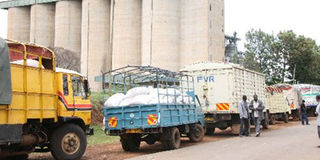Analysts: Inflation to fall below 20 p.c.

Experts expect the rate to fall to below 20 per cent in the year, but on condition of a continued fall in food and fuel prices. Photo/FILE
The high cost of living eased in December 2008, albeit marginally, as the festive month recorded a dramatic fall in maize flour and fuel prices.
But in what mirrors the big divide among the rich and the poor in the country the rich have it easy at the top facing only half the inflationary pressure the poor are experiencing.
The latest official data shows that overall inflation declined slightly by over one and half percentage points from 29.4 per cent in November 2008 to 27.7 per cent in December 2008.
“The decline in overall inflation reflected lower prices of food items, mainly the prices of maize flour,” the Government says.
Experts expect the rate to fall to below 20 per cent in the year, but on condition of a continued fall in food and fuel prices.
The price of maize flour fell from a high of Sh120 per two kilos to about Sh70, with the government “sponsored” maize flour retailing at Sh130 per five kilo bag, translating to about Sh52 per two kilos.
Pump prices has also fallen from a high of Sh102 per litre of petrol in November to an average of Sh76.
In the group category, the rich, mirrored by the Nairobi middle/upper income group, experienced the lowest inflationary pressure in December 2008 at 14.0 per cent compared with 15.5 per cent in November 2008.
In contrast, the Nairobi lower income group experienced 29.7 per cent inflationary pressure in December 2008, despite the rate falling from a high of 32.3 per cent.
The “Rest of Kenya” faced a 28 per cent increase in their cost of goods and services down from 30 per cent in November 2008.
This means that the wealth of Kenya’s rich is eroding at half the rate that the poor and the rest of the country’s wealth is losing value, which only goes to widen the divide.
The difference is as a result of inflationary pressure coming from categories that take a larger portion of individual group income.
Notably, the Nairobi lower income group and “Rest of Kenya” spend over 50 per cent of their income on the food and drink category whose price increase is usually the highest.
In December, inflation on food and drink category was 37.5 per cent in December 2008, down from a high of 39.4 per cent in November.
In contrast, luxury items such as alcohol and tobacco, recreation and education, personal goods and services, and clothing and footwear-where the rich spend most of their income-are normally at single digit inflation rate.
In December 2008, inflation for the recreation and education category, and the personal goods and services category declined from 7.1 per cent and 10.3 per cent, respectively, in November 2008 to 7 per cent and 9.9 per cent in December 2008.
And while that of clothing and footwear category increased from six per cent in November 2008, it remained at single digit level, at 6.1 per cent in December 2008.




